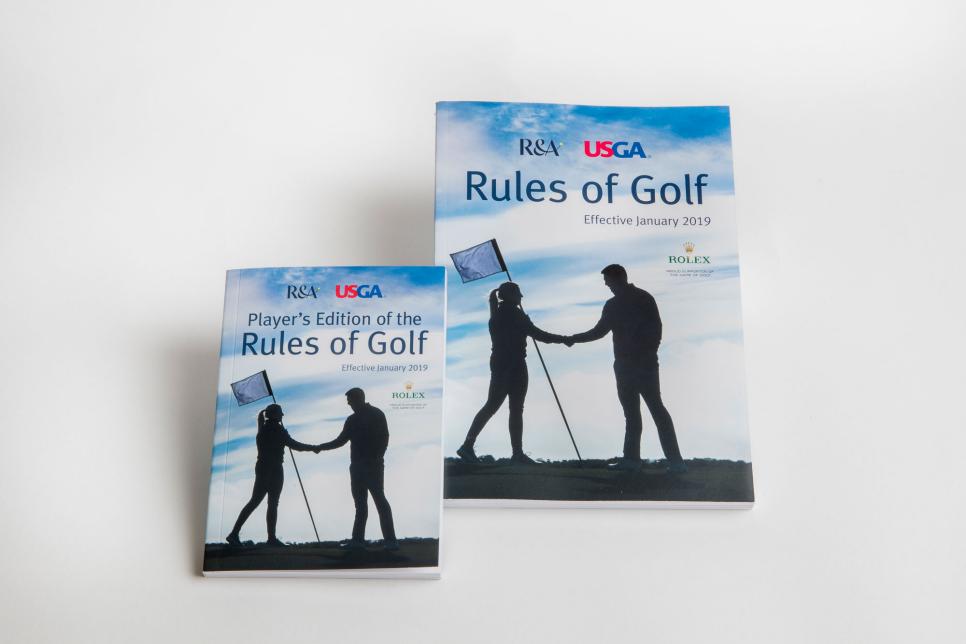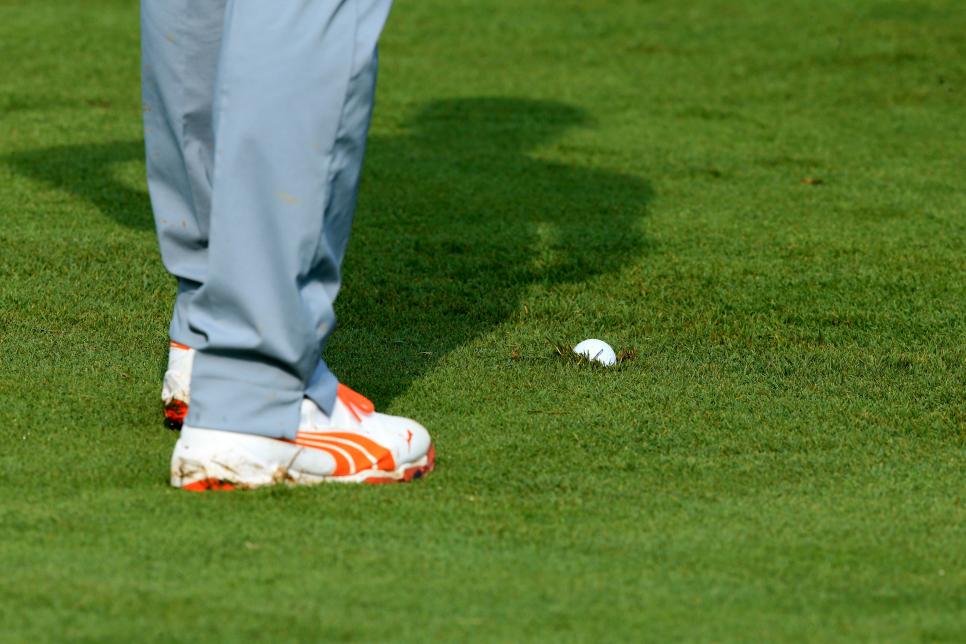
Jan. 1, 2019 has arrived and golf rings in not only a new year but a new era as the most extensive revisions in decades to the Rules of Golf officially go into effect. Years in the making, the much-talked-about modernized Rules bring with them an assortment of changes that will impact golfers at all levels. The premise guiding officials with the USGA and R&A in writing the new Rules was to make them easier to understand and apply, and they’ve succeeded largely in accomplishing that goal. In turn, the changes—specifically the relaxing of certain rules where the punishment was more severe than warranted—are likely to make golf simpler to play and more enjoyable. Here are 14 ways your game can benefit immediately from the new Rules.
You’re don’t have to worry if you accidentally cause your ball to move on the green
After the whole Dustin Johnson affair at the 2016 U.S. Open, the USGA and R&A created a local rule that eliminates any penalty if a ball moves on the green while the player has done nothing more than take normal actions to prepare for a stroke. The substance of that local rule has now been codified under Rule 13.1d. If you accidentally hit your ball with your backswing, move your ball while marking it, even mistakenly kick your ball, there is no penalty so long as you return the ball to its original spot. The same is true if you move your ball marker; replace the mark where it was and you’re good to go.

David Cannon
No more tip-toeing around when searching for your ball
Finding an errant shot after hitting it can be a chore, especially when it’s gone into the rough. This previously came with the added burden that if you weren’t careful and stepped on or moved the ball during your search, you were subject to a penalty. (Meanwhile, other players and spectators could search with no potential for penalty, creating a weird incentive for a player not to look for his or her ball.) Under new Rule 7.4, that’s no longer a worry as players who accidentally cause their ball to move during the search will receive no penalty. Simply replace the ball where it was originally lying or, if that exact spot is unknown, at an estimated original spot.
Rules regarding playing with a broken club are much simpler
Confusion often reigned over how to handle a situation in which you damaged a club during a round. Do it in the normal course of play, and you could continue to use the club or replace it without penalty. If you caused the damage in anger, however, you could not replace it or use it again. And if you did use it while damaged, even if you didn’t know it was damaged until after you hit a shot with it, the penalty was severe: disqualification. Such an incident happened last summer at the KPMG Women’s PGA Championship when LPGA veteran Lee-Anne Pace got upset after hitting a poor chip and slammed her wedge into a nearby stake in frustration. Unknowingly, she damaged the hosel of the club, and played a shot with the club again later in the round. Only then did she notice it was damaged. After talking to a rules official Pace walked off the course with four holes left knowing she was out of the tournament come the end of the round. Now no matter how the club was damaged, it can continue to be used during a round. Where this likely will have the biggest impact is with the putter. If you frustrating bang your flat stick after a missed putt and incidentally alter the face or hosel, you can continue to use the club and not have to start putting with a 3-iron or wedge the rest of your round.

Andrew Redington
Mistakenly double hitting a chip won’t cost you
It comes three decades too late for T.C. Chen, the golfer most famously associated with accidentally hitting his ball a second time with his follow-through when he did it while in contention in the final round of the 1985 U.S. Open. But rules makers finally came to the same conclusion others had long ago: A double hit is almost always accidental, and the outcome is so random as to hardly be beneficial. No need to embarrass yourself more by having to add an extra stroke to your score.
Spike marks on the green don’t have to ruin your chance at a birdie
Golfers often complained that there wasn’t much logic in the fact they could fix pitch marks on a green but not spike marks. Rules officials agreed when creating Rule 13.1c(2), which allows for repair of almost any damage on the green, including spike marks, shoe damage, indentations from a club or flagstick and animal damage. The exceptions that remain are aeration holes, natural surface imperfections and natural wear of a hole.

Drew Hallowell
Go ahead and touch the line of your putt (within reason)
The prohibition of a player (or his caddie) touching the line of play on the putting green felt like another ticky-tack rule that created confusion given there were seven different exceptions listed to the old rule. That prohibition has been lifted, although players are still not allowed to improve their line of play on the green (or anywhere on the course for that matter). Caddies can now use the flagstick and gently touch the putting surface to help you with your read.
You don’t have to be nervous about playing from a water hazard
Actually, there is no such thing as a “water hazard” any more. The new Rules redefine it as a “penalty area” that also encompasses spots where balls are lost or unable to be played. (Yeah, that’s going to take some getting used to.) With the new name comes fewer restrictions for what you can and can’t do inside these designated spots. You can now touch or move loose impediments as well as touch the ground with your hand or a club during a practice swing, so long as you’re not improving the conditions for the stroke. USGA and R&A officials saw the old rule the way most golfers did: impractical and extremely difficult to apply. Seriously, if your club grazed a tall blade of grass in the hazard that was inconsequential to the stroke, you were still subject to a penalty. But not anymore.
Same goes for when you’re playing a shot from a bunker
The new Rules also allow you to touch or move loose impediments from a bunker. “The challenge of playing from a bunker is the need to play out of the sand, not to play with leaves stones or other loose impediments left in place in the bunker,” write USGA/R&A officials in explaining the change. Remember, though, you still can’t deliberately touch the sand with your hand, club, rake or other objects to test its condition, and touching the sand with a club during a practice swing or in the backswing of a stroke is also still prohibited.
You can leave the flagstick while putting on the green without fear
We’re not as smart as Bryson DeChambeau, so we don’t know if leaving a flagstick in the hole will actually help us make more putts (officials didn’t think so when deciding to allow for it under the new Rules). But we do know creating one less burden to worry about on the greens will speed up play.
There’s a new OB option that will save time
USGA and R&A officials have established a local rule that clubs can adopt to offers an alternative to the stroke-and-distance penalty for lost balls or shots hit out-of-bounds. Golfers can now drop a ball anywhere between where the original ball was believed to come to rest (or went out-of-bounds) and just into the edge of the fairway, but no nearer the hole. If you take this option, you must add two strokes to your score, but you can play on instead of returning to the tee or the spot you hit your last shot. Essentially this mimics your score if you had played a decent provisional ball—and could actually improve it if you hit that provisional almost as poorly as the first one.

Courtesy of the USGA and R&A
DMDs are A-OK
In the previous edition of the Rules, Distance Measuring Devices have been allowed so long as a course has applied a local rule. Now, they are always allowed unless a course restricts their use via a local rule, usually for competitions.
Accidentally hitting yourself with your ball might hurt your physically, but won’t hurt your score
The old Rules had no penalty if a ball hits your opponents or their equipment, so why was there one if you accidentally deflected your own shot? Like with a double hit, the outcome when knocking a ball off your own body is random and unpredictable, so an added penalty seems excessive. If you deliberately position your equipment to intentionally use it as a backstop, and the ball hits it, you can is still a penalty.
You can now take relief for an embedded ball anywhere
One other rule where the old default position has been reversed. Rule 16.3 will allow for relief for a ball embedded anywhere in the “general area” (formerly known as “through the green”) except when embedded in sand. In taking relief, players will take a drop within one club-length of the spot where the ball was embedded. Officials say this is an appropriate exception to the principle of playing the ball as it lies because having to play a ball stuck in soft, wet ground, whether fairway or rough, should not be considered part of the normal challenge of playing a course. A course can still adopt a local rule to restrict relief to a ball embedded in parts of the course cut to fairway height or less.

David Cannon
You can get relief outside a bunker from an unplayable ball in the sand
But it will cost two penalty strokes if you choose it. Rule 19.3b allows players who have lies close to a lip or bunker wall to drop on the line of play outside the bunker rather than frustratingly take multiple tries to play the ball from the bunker.

